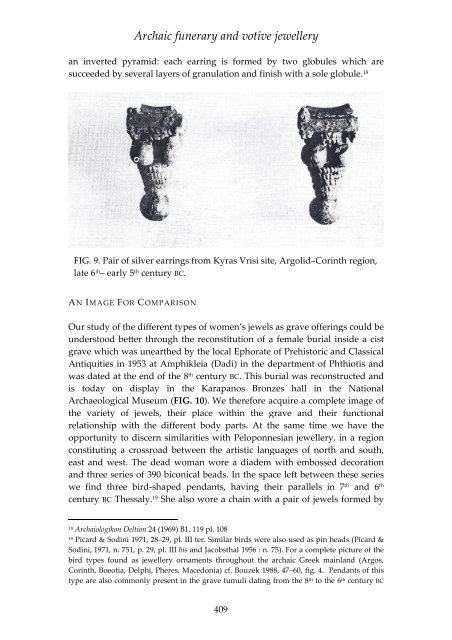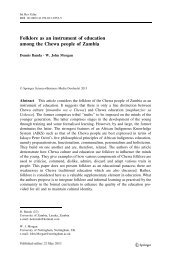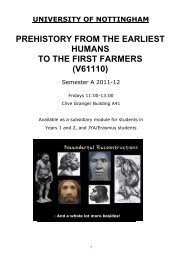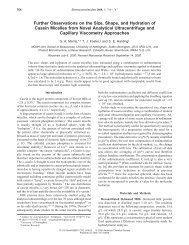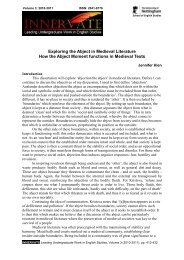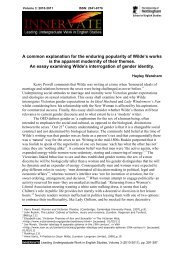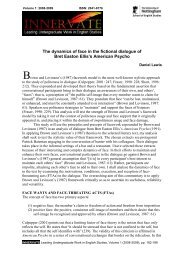Honouring the Dead in the Peloponnese - University of Nottingham
Honouring the Dead in the Peloponnese - University of Nottingham
Honouring the Dead in the Peloponnese - University of Nottingham
Create successful ePaper yourself
Turn your PDF publications into a flip-book with our unique Google optimized e-Paper software.
Archaic funerary and votive jewellery<br />
an <strong>in</strong>verted pyramid: each earr<strong>in</strong>g is formed by two globules which are<br />
succeeded by several layers <strong>of</strong> granulation and f<strong>in</strong>ish with a sole globule. 18<br />
FIG. 9. Pair <strong>of</strong> silver earr<strong>in</strong>gs from Kyras Vrisi site, Argolid–Cor<strong>in</strong>th region,<br />
late 6 th – early 5 th century BC.<br />
AN IMAGE FOR COMPARISON<br />
Our study <strong>of</strong> <strong>the</strong> different types <strong>of</strong> women’s jewels as grave <strong>of</strong>fer<strong>in</strong>gs could be<br />
understood better through <strong>the</strong> reconstitution <strong>of</strong> a female burial <strong>in</strong>side a cist<br />
grave which was unear<strong>the</strong>d by <strong>the</strong> local Ephorate <strong>of</strong> Prehistoric and Classical<br />
Antiquities <strong>in</strong> 1953 at Amphikleia (Dadi) <strong>in</strong> <strong>the</strong> department <strong>of</strong> Phthiotis and<br />
was dated at <strong>the</strong> end <strong>of</strong> <strong>the</strong> 8 th century BC. This burial was reconstructed and<br />
is today on display <strong>in</strong> <strong>the</strong> Karapanos Bronzes hall <strong>in</strong> <strong>the</strong> National<br />
Archaeological Museum (FIG. 10). We <strong>the</strong>refore acquire a complete image <strong>of</strong><br />
<strong>the</strong> variety <strong>of</strong> jewels, <strong>the</strong>ir place with<strong>in</strong> <strong>the</strong> grave and <strong>the</strong>ir functional<br />
relationship with <strong>the</strong> different body parts. At <strong>the</strong> same time we have <strong>the</strong><br />
opportunity to discern similarities with Peloponnesian jewellery, <strong>in</strong> a region<br />
constitut<strong>in</strong>g a crossroad between <strong>the</strong> artistic languages <strong>of</strong> north and south,<br />
east and west. The dead woman wore a diadem with embossed decoration<br />
and three series <strong>of</strong> 390 biconical beads. In <strong>the</strong> space left between <strong>the</strong>se series<br />
we f<strong>in</strong>d three bird-shaped pendants, hav<strong>in</strong>g <strong>the</strong>ir parallels <strong>in</strong> 7 th and 6 th<br />
century BC Thessaly. 19 She also wore a cha<strong>in</strong> with a pair <strong>of</strong> jewels formed by<br />
18<br />
Archaiologikon Deltion 24 (1969) Β1, 119 pl. 108<br />
19<br />
Picard & Sod<strong>in</strong>i 1971, 28–29, pl. III ter. Similar birds were also used as p<strong>in</strong> heads (Picard &<br />
Sod<strong>in</strong>i, 1971, n. 751, p. 29, pl. III bis and Jacobsthal 1956 : n. 75). For a complete picture <strong>of</strong> <strong>the</strong><br />
bird types found as jewellery ornaments throughout <strong>the</strong> archaic Greek ma<strong>in</strong>land (Argos,<br />
Cor<strong>in</strong>th, Boeotia, Delphi, Pheres, Macedonia) cf. Bouzek 1988, 47–60, fig. 4. Pendants <strong>of</strong> this<br />
type are also commonly present <strong>in</strong> <strong>the</strong> grave tumuli dat<strong>in</strong>g from <strong>the</strong> 8 th to <strong>the</strong> 6 th century BC<br />
409


